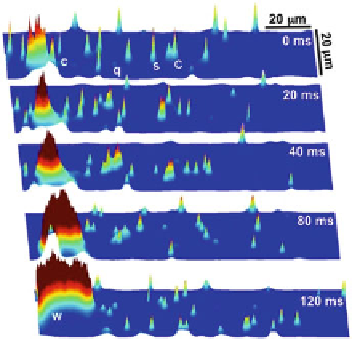Biology Reference
In-Depth Information
a
b
Computer simulation
Low [Ca]
High [Ca]
10
4
10
3
10
3
10
2
10
2
10
1
10
1
10
0
10
0
1
10
1
2
3
4
5
Cluster size
Cluster size
c
Experiment
Low [Ca]
High [Ca]
2
10
10
2
10
1
10
1
10
0
0
10
1
2
3
4
1
10
Cluster size
Cluster size
Fig. 10.4
Transition from sparks to waves in a CRU network
.(a) 3D plots showing coexistence of
Ca
2+
quarks (q), sparks (s), spark clusters (c), and waves (w) in a slice of the 3D CRU network
model with high Ca
2+
. A large cluster (
left end
) eventually evolved in to a wave. (b) Spark cluster
size distributions at low and high Ca
2+
concentrations from the computer model. (c) Same as b but
from a mouse ventricular myocyte
status of its surrounding CRUs. In another study (Nivala et al.
2012b
), we combined
computer simulation, theory, and experiments to show that
criticality
is responsible
for the transition from local to global Ca
2+
signaling, providing a general theoretical
framework for understanding this transition. We calculated the distributions of the
spark cluster sizes in both the computer model and in permeabilized mouse ventric-
ular myocytes (Figs.
10.4b and c
). At low Ca
2+
loads, the cluster size distribution
was exponential. As the Ca
2+
load increased, the distribution changed toward a
power law. We showed that the coupling between the CRUs plays a key role in the
occurrence of power-law distribution. A power-law distribution is an indicator that
a system is in a critical state, such as the critical phenomena of second-order phase
transitions in thermodynamics and statistical physics (Stanley
1971
,
1999
) and self-
organized criticality observed in many complex nonlinear systems in nature (Bak
et al.
1988
;Bak
1997
; Turcotte and Rundle
2002
). The fact that criticality is the
governing mechanism of the Ca
2+
signaling hierarchy has several implications:
(1) Once a system is in a critical state, a tiny perturbation can grow into a
macroscopic fluctuation due to the power-law distribution (Stanley
1971
,
1999
).
This provides a general theoretical framework for understanding how single chan-
nel fluctuations may lead to macroscopic random oscillations; (2) Ca
2+
oscillations
are self-organized activities, which are emergent phenomena of the coupled CRU
network, and do not require the preexistence of pacemaking sites. Due to the
randomness in cluster formation in time and space, the whole-cell Ca
2+
signal
exhibits an irregular burst-like behavior (Skupin et al.
2008
,
2010
); and (3) in
sino-atrial nodal cells of the heart, local Ca
2+
release was shown to play a vital




















































Search WWH ::

Custom Search